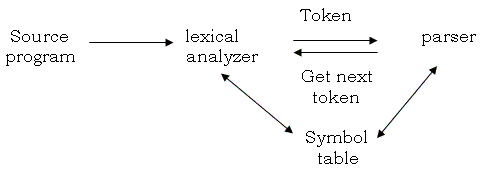Definition of Compiler:
1. A computer program which reads source
code and outputs assembly code or executable code is called compiler.
2. A program that translates software
written in source code into instructions that a computer can understand
Software used to translate the text that a programmer writes into a format
the CPU can use.
3. A piece of software that takes third-generation
language code and translates it into a specific assembly code. Compilers
can be quite complicated pieces of software.
Compiler Overview:
Consider process of Executing Simple C
Language Code –
We have opened C Code editor and wrote
simple C Program, whenever we try to
Compile
code and try to execute code our code is given to the compiler.
int main()
{
printf("Hello");
return(0);
}
Now our main intention is to convert
program into lower level language which can
Be read by Machine. Compilers have
different phases, and program undergoes through these 6 phases. After Passing
through all the compilation Phases our code
is
converted into the machine level language code which can be read by machine.
Different
Phases of Compiler
1. Lexical
Analysis Phase
2. Syntax Analysis
3. Semantic Analysis
4.
Intermediate Code Generation
5.
Code Optimizer
6. Code Generation
Lexical
Analysis – Compiler:
Compiler
:
Compiler takes high level human readable
program as input and convert it into the lower level code.This conversion takes
place using different phases.First phase of compiler is lexical analysis.
Must Read : [What
is Compiler ?]
Different
phases of compilers :
1.
Analysis
Phase
2. Synthesis
Phase
1.Analysis
Phase :
Lexical analysis
Syntax analysis
Semantic analysis
Lexical
Analysis Phase :
Task of Lexical Analysis is to read the
input characters and produce as output a sequence of tokens that the parser
uses for syntax analysis.
1. Lexical Analyzer
is First Phase Of Compiler.
2.
Input
to Lexical Analyzer is “Source Code“
3.
Lexical
Analysis Identifies Different Lexical Units in a Source Code.
4.
Different
Lexical Classes or Tokens or Lexemes
- Identifiers
- Constants
- Keywords
- Operators
5. Example
: sum = num1 + num2
So Lexical Analyzer Will Produce
following Symbol Table -
Token
|
Type
|
sum
|
Identifier
|
=
|
Operator
|
num1
|
Identifier
|
+
|
Operator
|
num2
|
Identifier
|
;
|
Seperator
|
6.Lexical
Analyzer is also called “Linear Phase” or “Linear Analysis”
or “Scanning“
7.Individual Token is also Called Lexeme
8.Lexical Analyzer’s Output is given to Syntax Analysis.
Syntax Analysis – Compiler
Analysis Phase : 2nd Phase of
Compiler (Syntax Analysis)
During the first Scanning
phase i.e Lexical Analysis Phase of the compiler , symbol table is
created by the compiler which contain the list of leximes or tokens.
Syntax Analysis :
1.
It
is Second Phase Of Compiler after
Lexical Analyzer
2.
It
is also Called as Hierarchical Analysis or Parsing.
3.
It
Groups Tokens of source Program into Grammatical Production
4.
In
Short Syntax Analysis Generates Parse Tree
Parse Tree Generation :
SUM
= NUM1 + NUM2
Now Consider above C Programming statement. In this
statement we Syntax Analyzer will create a parse tree from the tokens.
Explanation
: Syntax Analysis
We know , Addition operator plus (‘+’)
operates on two Operands
Syntax
analyzer will just check whether plus operator has two operands or not . It
does not checks the type of operands.
Suppose One
of the Operand is String and other is Integer then it does not throw error as
it only checks whether there are two operands associated with ‘+’ or not .
So this Phase
is also called Hierarchical Analysis as it generates Parse Tree Representation
of the Tokens generated by LexicalAnalyzer
Semantic Analysis –
Compiler
Syntax
analyzer will just create parse tree. Semantic Analyzer will check actual
meaning of the statement parsed in parse tree. Semantic analysis can compare
information in one part of a parse tree to that in another part (e.g., compare
reference to variable agrees with its declaration, or that parameters to a
function call match the function definition).
Semantic
Analysis is used for the following -
1.
Maintaining the Symbol Table for each block.
2.
Check
Source Program for Semantic Errors.
3.
Collect Type Information for Code
Generation.
4. Reporting
compile-time errors in the code
(except syntactic errors, which are caught by syntactic analysis)
5.
Generating the object code (e.g., assembler
or intermediate code)
Now
In the Semantic Analysis Compiler Will Check -
1.
Data
Type of First Operand
2.
Data
Type of Second Operand
3.
Check
Whether + is Binary or Unary.
4.
Check for Number of Operands Supplied to
Operator Depending on Type of
Operator (Unary | Binary |
Ternary)




